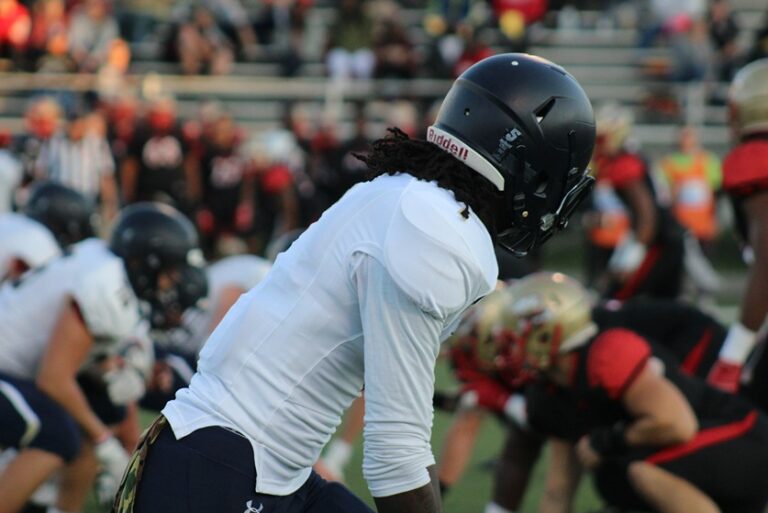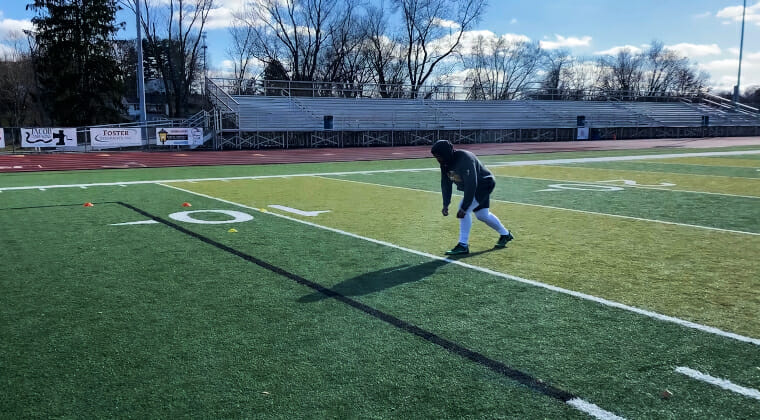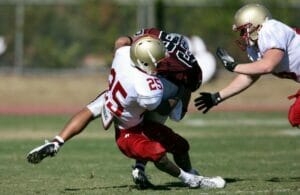
Wide Receiver in Football
Written By: Gridiron Elite Training

Wide Receiver in Football
Written By: Gridiron Elite Training
The role of a wide receiver in football is one that many find fascinating, and with good reason. These athletes possess a unique combination of skills, including speed, agility, and precise route-running, which allows them to excel at their position on the field.
This post will explore the wide receiver football position in detail, shedding light on the responsibilities, skills, and importance of this crucial offensive player. We’ll also discuss how the wide receiver position has evolved over the years, as well as some of the greatest wide receivers to ever grace the field.

Understanding the Wide Receiver Position
The wide receiver position is a key offensive role in both American and Canadian football. As a vital part of the passing game, wide receivers are responsible for catching passes thrown by the quarterback and advancing the ball down the field. Their primary objective is to gain yardage, ultimately scoring touchdowns or setting up scoring opportunities for their teammates.
Wide receivers line up on either side of the offensive line, usually near the sidelines. Depending on the formation, there may be anywhere from one to four wide receivers on the field at any given time. They must be aware of the line of scrimmage and ensure they are onside before the ball is snapped, or they risk incurring a penalty.
The Responsibilities of a Wide Receiver in Football
The wide receiver’s role in football goes beyond merely catching passes. Here are some of their key responsibilities:
- Running precise routes: Wide receivers must be adept at running well-defined routes, enabling them to create separation from defenders and position themselves to receive a pass. This involves understanding the team’s playbook, knowing when to make cuts, and maintaining the proper depth in their routes.
- Catching the ball: A wide receiver must have exceptional hand-eye coordination and the ability to catch passes thrown at varying speeds and trajectories. This often involves leaping, diving, or contorting their bodies to secure the catch while remaining inbounds.
- Gaining yards after the catch (YAC): Once a wide receiver has caught the ball, they must use their speed, agility, and elusiveness to evade defenders and gain additional yardage. This skill, known as yards after the catch, can be the difference between a modest gain and a game-changing play.
- Blocking: Although not their primary responsibility, wide receivers must also contribute to the run game by blocking for their teammates. This involves engaging defenders and creating running lanes for the ball carrier.

Essential Skills for a Wide Receiver
To excel at the wide receiver football position, players must possess a unique set of skills:
- Speed: Wide receivers must be fast enough to outrun defenders, create separation, and turn short passes into big gains.
- Agility: Exceptional agility allows wide receivers to change direction quickly and make sharp cuts during their routes, making it difficult for defenders to cover them.
- Hands: Strong, reliable hands are essential for a wide receiver, as they must be able to secure catches in various situations, often under pressure from defenders.
- Route-running: Mastery of route-running is critical for a wide receiver, as it enables them to deceive defenders and create open spaces on the field.
- Football IQ: Wide receivers must have a deep understanding of the game, including defensive coverages, offensive plays, and the ability to read defenses on the fly.
The Evolution of the Wide Receiver Position

The wide receiver position has evolved significantly over the years, as the game of football has become more pass-centric. Early wide receivers were primarily used as blockers, but as passing offenses developed, the role of the wide receiver expanded. Today, wide receivers are key contributors to their team’s offensive success, and many are considered among the most exciting and dynamic athletes in the sport.
One of the key factors driving the evolution of the wide receiver position is the increasing emphasis on the passing game. As passing offenses have become more sophisticated, wide receivers have taken on greater importance within their teams’ offensive strategies. This shift has led to the development of different types of wide receivers, each with their own unique skill sets.
- Traditional wide receivers: These players excel at running routes and catching passes, relying on their speed, agility, and hands to make plays.
- Slot receivers: Typically smaller and quicker than traditional wide receivers, slot receivers specialize in exploiting mismatches against linebackers and safeties. They often operate in the middle of the field, using their quickness and route-running skills to create separation.
- Deep-threat receivers: Known for their blazing speed, deep-threat receivers stretch the field vertically, drawing defensive attention and opening up opportunities for their teammates.
Legendary Wide Receivers in Football History
Throughout the history of football, many wide receivers have left their mark on the game with their incredible talent and accomplishments. Here are a few of the all-time greats:
- Jerry Rice: Often considered the greatest wide receiver of all time, Rice set numerous records during his career, including most career receptions, receiving yards, and receiving touchdowns.
- Randy Moss: Known for his unbelievable athleticism, Moss was a game-changer at the wide receiver position. His ability to stretch the field and make acrobatic catches made him one of the most feared receivers in NFL history.
- Terrell Owens: Owens was a dominant force throughout his career, combining size, speed, and route-running skills to become one of the best wide receivers of all time.
- Larry Fitzgerald: Renowned for his exceptional hands and route-running, Fitzgerald has been a consistent performer throughout his career, amassing impressive statistics and numerous Pro Bowl selections.
Finishing Tips For Wide Receivers

The role of a wide receiver in football is both complex and exciting. As a key component of the passing game, wide receivers must possess a range of skills, including speed, agility, route-running, and reliable hands.
The evolution of the wide receiver position has led to the development of various types of receivers, each with their own unique skill sets. As the game continues to evolve, the importance of the wide receiver football position will undoubtedly continue to grow, as these athletes play a crucial role in their teams’ offensive success.
Subscribe To Get Updates On Newly Released Articles
Don't forget to share this post!
Continue Reading More Football Recruiting Tips Below
Related Articles

5 Keys to the College Football Recruiting Process
If you are a high school football player, it’s easy to get lost in the college football recruiting process. This article will break down key stages of the recruiting process.

Junior College Football Recruiting
If you’re thinking about playing college football, read this article for quick tips on the process of juco college football recruiting.

Complete Guide to Football Recruiting Rankings
Find out why football recruiting rankings are important, where they come from, what they mean and how they affect your recruiting strategy.

Gridiron Elite Training was started to help educate and provide football players with a community to receive proper training and guidance.
We created “The Gridiron Elite Academy” which is an online football performance network that provides football players of all levels with sports performance workout programs, football position-specific drills, mindset coaching, mental toughness training, recruiting guidance and help, and nutrition programs.


